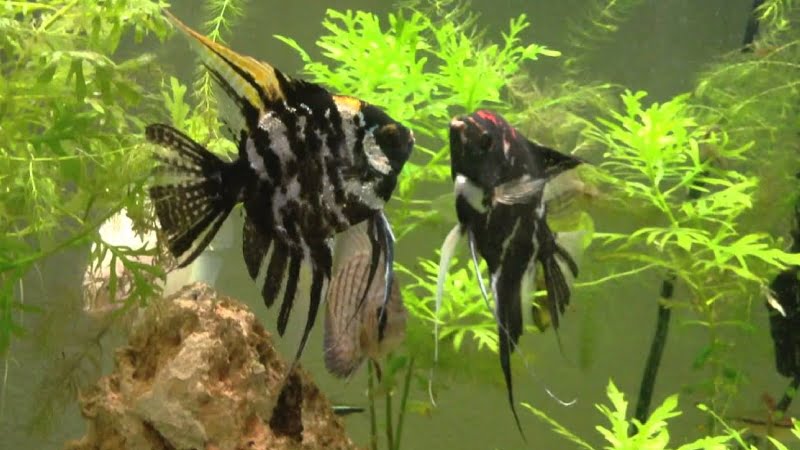Do Angelfish fight? That’s always the question whenever I notice the aggressive behavior that is known to be present in my angelfish, I take note. There are times when the situation mildens over time.
There were times, however, when the creatures tore each other’s fins off, but those occurrences were rare. My angelfish have become accustomed to some techniques over the years to keep them from fighting, so I’ve learned them over time.
In order to overcome this problem in the first place, I must understand the cause of the issue.
There are several steps that need to be taken to ensure that angelfish do not fight:
- Make sure you do not have any mating between your angelfish but rather make sure they are fighting.
- Make sure that the breeding pairs, which are inherently more aggressive, are separated.
- The fish you will be raised should be kept in relatively large tanks (of at least 22 gallons).
- It is suggested that you group the angelfish together into groups of five.
- In order to get rid of aggressive angelfish, you need to isolate them in a different tank for a few days.
- Make sure your aquarium has a large amount of vegetation.
It is my experience that these six steps are effective in reducing aggression among angelfish and preventing fighters within them.
Unfortunately, it is quite tricky to implement these techniques in practice. That being said, I will go over each one and show you what I am specifically inclined to do for each one.
Related Articles
- Do Angelfish Like To Hide? 7 Reasons Will Answer All Your Wonders
- Do Angelfish Get Lonely? – 3 Things You Need To Know
- Do Angelfish Fight And 6 Ways To Make Them Stop Fighting With Others
- Freshwater Angelfish Fundamentals – Care Guide: Lifespan, Size, Diet, Habitat & More
Keeping Angelfish From Fighting
It is difficult to understand the complex nature of angelfishes. Being fish means that it is difficult to control their aggression and retaliation as a result of their natural characteristics.
As a result, the fish cannot exactly be separated whenever they get into an argument. Additionally, you can’t always be present when they are fighting.
You can never simply leave your tank behind wherever you go, unlike a dog. In this case, you must take steps to resolve the issue once and for all if your angels are fighting. However, this may require the purchase of a few new fish as a last resort.
There is, of course, no use in just knowing what causes angelfish to fight. You have to address the issues they might be experiencing at the same time.
In the second part of this article, I will explain how you can choose the right steps depending on the cause you have identified.
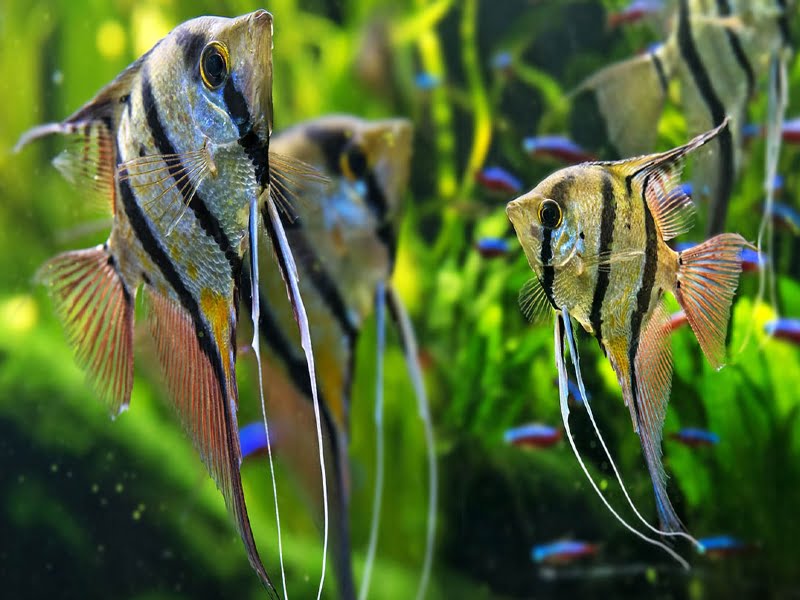
How To Ensure Your Angelfish Fight
It is important to know that what may appear to be a spat between angels may actually be the result of mating among them.
During the fighting, angelfish lock lips with each other. It should be noted that this is similar to what you can see when you observe a breeding pair forming in a tank.
I would caution you not to overreact to the situation until you have determined whether the angels are mating or fighting.
If the fish in your tank are of different genders, then you will be able to determine this for yourself. There is a high chance that you will have a breeding pair of angels if one is female and the other is aggressive.
Furthermore, you should pay attention to what happens after the lip-locking session.
It is possible that two angels are mating in the long run if one calms down and swims with the other angel for an extended period of time.
In order to reproduce, they will have to find a slate to lay eggs on and lay eggs there up to a point.
This phenomenon was previously mentioned in another article I wrote in which I answered the question: Why do angelfish lock lips?
Also, over the years I have developed a few techniques that I have found helpful in preventing this from happening (in case the situation is indicative of aggressive behavior).
Couples That Breed Separately
You may not think that spawning is a good sign, especially if your fish are fighting instead.
During spawning, angelfish become aggressive in order to reproduce. You are advised to move the breeding pair to a separate tank so that you will not be attracted to the fight that will result from the presence of angelfish eggs and fry.
Then their territorial behavior will not inconvenience other angelfish and thus they will be able to get as territorial as they want.
If spawning was to be prevented altogether, this problem could be resolved and you wouldn’t have to deal with it at all.
One way to solve this problem is to make sure that only the male angelfish are kept. Female angelfish are not capable of laying eggs.
Having all your angels be males will get rid of any concern about eggs and fry ever happening.
Increase The Size Of Your Aquarium
I suggest that you place your angels in a large aquarium. Considering that one angelfish needs 22 gallons of water to grow to its full potential, you need to keep that in mind.
If you want your angels to stretch their fins, it is your responsibility to provide as much space as possible for them to do that. Be careful not to overstock your tank.
Keeping several angels at once will require more than a 22-gallon tank, as you will need to keep them separate in the tank.
If you want to keep even more angels together, you’ll need twelve more gallons. By measuring the length and width of your angelfish, you may also be able to determine the size of the right aquarium.
The topic has been covered in more detail during this post, where I describe how to calculate the necessary aquarium dimensions, based on the number of angels you choose.
As well as linking to the calculator I personally use, which tells you exactly how long, wide, and high your frame needs to be in order to find the ideal size.
Choosing The Right Group Size
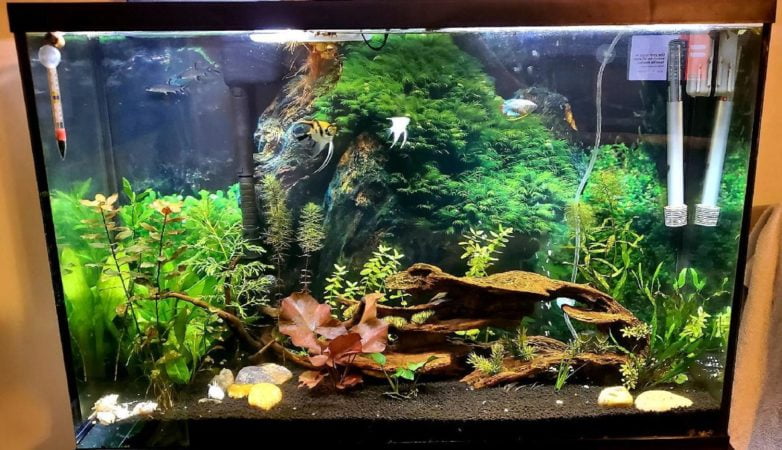
I think that overcrowding your aquarium is a bad idea. If your angels are crowded together, they may fight among themselves.
Having too few angelfish is also not recommended because they can end up getting sick.
Having too few angelfish encourages bullying and can result in them becoming sick.
There is a possibility that this can occur when you only have three or even four angelfish in your aquarium.
The angelfish may experience bullying from only one or two of them. If there are four angelfish in a group, three of them would be able to bully the fourth angelfish.
Therefore, I believe it is imperative for all tanks to have at least five angelfish.
If the aggression is spread among the angel fishes, it will ultimately prevent a single angelfish from having all the aggression directed at it.
When you encounter many angels at one time, fighting isn’t quite as intense, especially if they are equipped with a tank of some sort.
As part of the benefits of living on shores, energy consumption will also be reduced. The angelfish reap the benefits of sharing kinetic energy with each other when they swim next to each other.
Stop Territorialism
It is because angelfish are territorial that they will fight one another. Keep the peace in the sea by eliminating the areas that your angelfish have taken over and established territories in.
It is important to remove the angels from the tank before rearranging its layout in order for this to be possible.
I would recommend keeping the aggressive ones for several days in a separate tank. If there are still angels swimming peacefully, you should monitor them in order to see if they are feeling calmer.
After they have done so, try putting back the people you have removed, and notice whether their attitude has changed.
Consequently, your zone should be destroyed, which will force all your angels to play on an even playing field, since the dominating fish should have lost their territories.
Try removing other angelfish if the first step doesn’t work. It may be because you have picked the wrong angelfish to remove.
The Benefits Of Vegetation
Keep your tank stocked with foliage by filling it with as much foliage as you can. You should give your docile angelfish some plants and decorations behind which they can hide if they are being attacked by their more aggressive counterparts.
As soon as the target of a fish’s attack is out of sight, the fish generally halt their aggression.
Keeping a fish’s hiding place in your aquarium will help them avoid harm. As a result, the bullied people will be able to relax a little while at the same time the aggressors will have the opportunity to cool down.
How Are Your Angelfish Behaving?
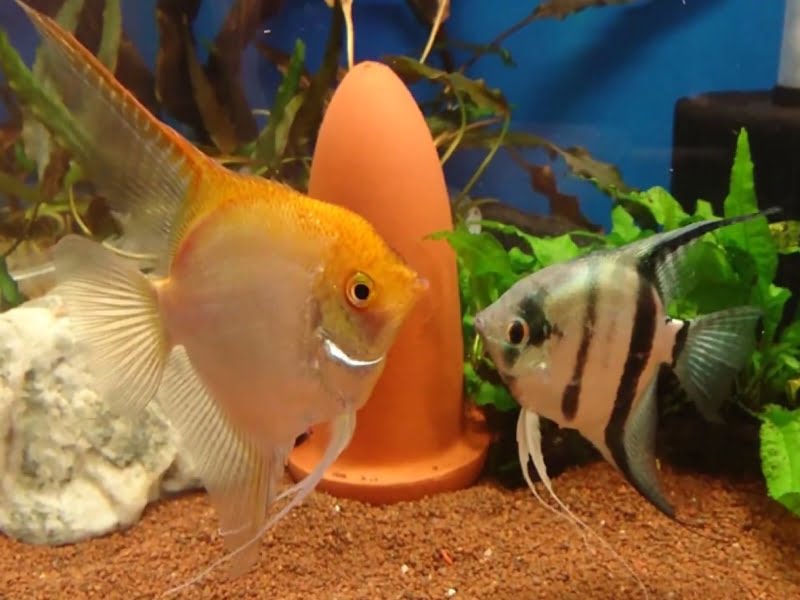
Almost always, there is a dog nearby, as well as other pets such as cats or other small animals.
Therefore, it is easy to determine if there is conflict among the animals. Upon hearing the commotion, you will be alerted to it or, at some point, you will see them fighting violently from close range.
There are no angelfish that can follow you because they cannot hear you, nor can they see you.
Due to this fact, you can’t expect to witness every single fight that takes place in that tank. In order to avoid missing anything, try to watch out for any signs of conflict.
There is a possibility that the fish has wounds and some kind of marks on its body, such as nipped fins.
Early recognition of the signs of fights can allow you to take steps to quickly resolve the matter if you catch them when they are still small. As well as all this, your angels are also fighting.
You should thus be suspecting that they are not just playing around with you.
Factors Associated With Angelfish Aggression
There are a few factors that you should keep in mind when dealing with the issue of violence among angelfish:
Amusement
It is very important that you have a good understanding of what fighting is. There is no proof that your fish have started fighting amongst themselves, even if they keep chasing each other around in the tank.
It might be that your tank is a little too small for your fish.
In some cases, they are merely playing around with each other. Before assuming that they are fighting, make sure you check the water first.
If, however, you notice that the fins of the fish have been bitten, then the story changes. It is a different matter if your angelfish get hurt while playing together.
Territory Establishment
There are two types of angelfish in this world: territorial and non-territorial. When it comes to mating, these characteristics become even more pronounced.
In an area where angelfish have been invaded, it is not uncommon for them to act violently towards creatures who attempt to invade their realm, including other angelfish.
Typically, however, in such cases, once the invading fish has left the area, the aggressive behavior will cease to exist.
In my opinion, the aggression that is manifested in this case cannot be regarded as a worry all the time. Generally speaking, the best course of action would be to observe patiently and remain calm.
Characteristics Of Aggressiveness
A picture of an angelfish that acts aggressively might not actually be a picture of the fish that actually acts aggressively.
Sometimes, though, it might be obvious that it really is an aggressive fish. In fact, there is a high incidence of fish bullying compared people think. Angelfish are not unusual in attacking smaller angelfish when they are larger.
In some cases, it can be difficult to pinpoint the reason for such behavior. Whenever a particular fish is choosing to remain isolated, especially when it is eating, you can assume that it is a victim of bullying.
If, once you have introduced food to the aquarium and one of the fish does not eat, while all the others do, then you are probably dealing with something very serious.
Angelfish can often be seen retreating from the surface of the water once another angelfish enters its proximity.
In order to stay hidden in your home, it will use the hiding places you have to avoid being seen.
In this case, cowering is a clear indication that there has been some fighting or bullying going on within the tank.
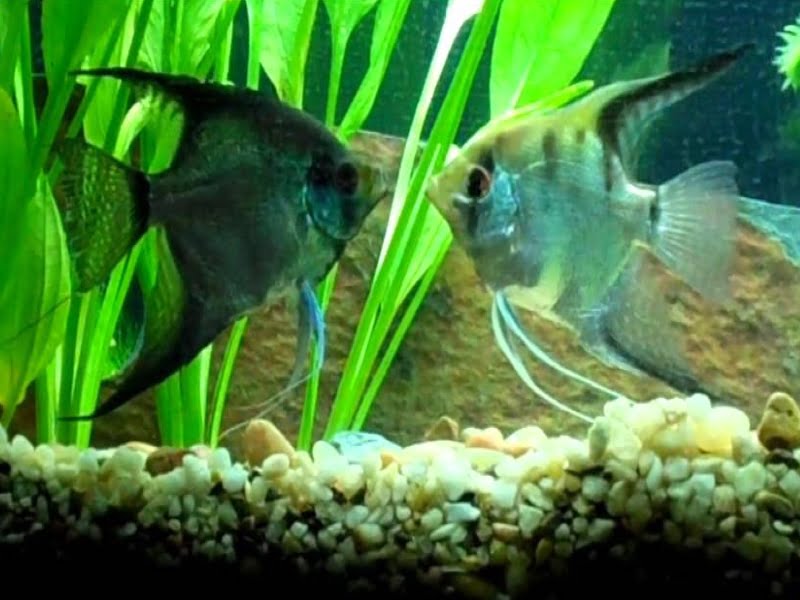
Why Do Angelfish Fight?
In the case of aggressive behavior, you should be careful not to overreact. It is important to know, however, that fighting among your angels isn’t healthy, so I recommend that you stop them before real harm can be done to them.
The idea of angelfish fighting is unimaginable to some people. After witnessing the occurrence of such behavior, it becomes overwhelming to them and they have no idea how they can prevent it in the future.
It is always best to start with determining the basic reasons why there are even fights in the first place in such circumstances.
The following are some possible causes of the problem:
Administrative Hierarchy
Hierarchy is very important in the world of angelfish. All groups are led by a leader who will be followed by all the members.
There is typically some sort of conflict occurring to establish this pecking order and thus determine this pecking order. In some cases, it might be worthwhile to be concerned about such fighting.
During this exercise, one of the fish needs to demonstrate that it is stronger than its competitors.
If there is a pecking order established and one fish becomes the top fish, the fighting tends to stop as soon as the leader is established. The number of fights will relax once the leader is established.
Although the pecking order can sometimes be established, there are instances where fighting persists nonetheless despite the pecking order.
You need to pay attention to conditions such as these. Bullying is one of the conditions that enter into this equation.
There should be no doubt that the supremacy of one angelfish can be proven, but if it still attacks the other angels, you should take action.
There are other factors that must be considered also that might be driving the aggression if we are to understand what is going on.
Tanks With A Small Volume
There is no great difficulty in rearing angelfish fry. You won’t be able to take them anywhere with you since they are so small.
The bowls whose sizes are appropriate to the occasion can be used to get the job done. In the case of fish owners, unfortunately, the size of the tanks they buy tends to be based on the number of young angelfish they are rearing at the time.
The fishes are taken into account, but the growth they will undergo at a later stage is not accounted for.
They therefore may end up having tanks that are simply too small to fit an angelfish of adult size in them, resulting in a problem. The small capacity of the tank will encourage fights between the angelfish.
To begin with, there is no way for them to avoid each other’s territory since they are in a battle of wills.
Furthermore, using small tanks will drastically reduce their fear of fighting and will persuade them that they have to fight in order to survive.
Generally speaking, it takes a year for the angelfish fry to mature, which means you must keep that in mind when working with them.
However, this happens only when the optimum conditions are in place. The tank should be adequately large, so I recommend that you purchase a relatively large tank from a company such as advanced.
Incredibly High Numbers
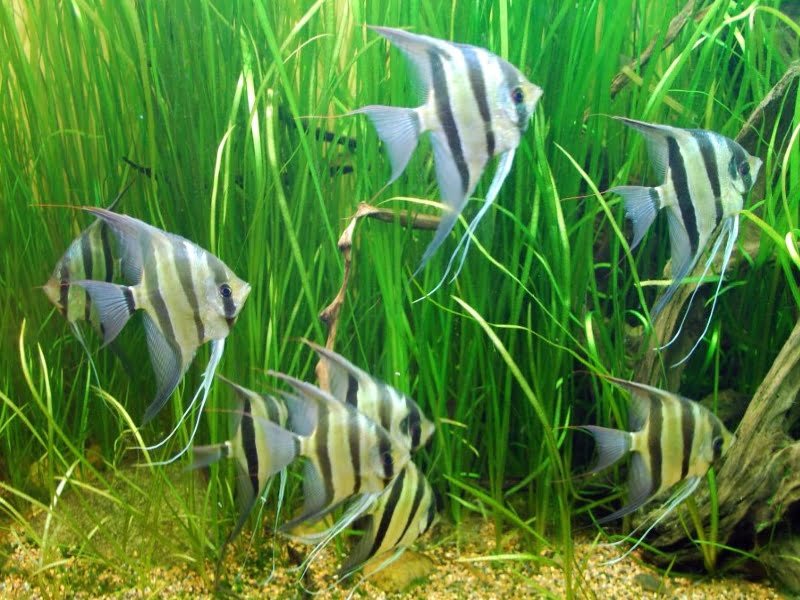
Overcrowding your tank would be the most likely method for causing angelfish to fight. In the event that you have too many angelfish in your aquarium, then it would be pointless to purchase a large one.
It is a question of the territory in which you keep the fish or how much that fish consumes. The reaction of your angels will be to engage in combat when they perceive that the fish are scarce.
There is also the possibility that too many angelfish being kept in close quarters can cause stress to the fish.
When stressed, fish can become aggressive and fight other fish. Please consider keeping this in mind when trying to decide how many angelfish you should keep together in one tank.
Reproduction & Spawning
During the breeding period, most angelfish have a tendency to become aggressive.
Angelfish are known to be extremely protective of their young during the breeding process.
The reason for this is that they are extremely territorial. It is worth noting that their aggression is sometimes justified, especially if the other angels continue to attack their babies and eggs every so often.
On the other hand, they can sometimes act in an irrational manner. It is not uncommon to see one of the pairs attacking the other pair.
Regardless of the reason for your angelfish’s spawning, a fight is possibly on the horizon as long as they are spawning.
Food Insufficiency
Keeping a fish as a pet is the same as keeping any other type of animal. Overfeeding them will not make them healthy, however, and you should keep a minimum of 20 fish in one aquarium.
In the event that you underfeed them, however, they may get into a fight. Angels are known to react negatively to the perception that resources are limited, as was mentioned above.
There are many ways to make the tank less efficient, but limiting the number of available resources will not work.
If you fail to feed your angels in the amounts that are necessary, you will not be able to avoid violence.
Video About Fighting Of Angelfish
Conclusions
Angelfish are known to fight and be aggressive towards one another. Having said that, sometimes you just need something to amuse yourself by nipping and lip-locking.
I would suggest that you observe which is which in order to distinguish between them. There is something you should do if you see your angels showing signs of damage such as the nips that have been made on their fins.
Getting to the bottom of the issue is mainly about reducing stress. If you want to provide your angels with plenty of vegetation, then you can do that by providing a large tank for them.
Additionally, if possible, avoid clogging up your tank with too many creatures. The best practice is probably to keep them in small groups of five.
This was my first time writing an article, so I hope you found it helpful in some way. It’s important to experiment in order to figure out what works and what doesn’t.
Take the time to experiment and see which one helps your aquarium the most. No matter which route you choose, you will be successful.

Annette M. Chaney is an experienced marine biologist with over 20 years of experience as an aquarist and fishkeeper. She started her first aquarium at a young age, filling it with frogs and goldfish obtained from the ten-cent pet store.
Annette grew up caring for and breeding African Cichlids, which led to a hobby in high school that doubled as a profitable means. Attending Reed College gave her time to solidify herself as an accomplished aquarium caretaker with an eye for sales. After that, from 2009 – 2013, she studied at Roger Williams University – one of the most prestigious universities for Aquaculture and Aquarium in USA. She is the founder of AquariumCircle since 2010.
